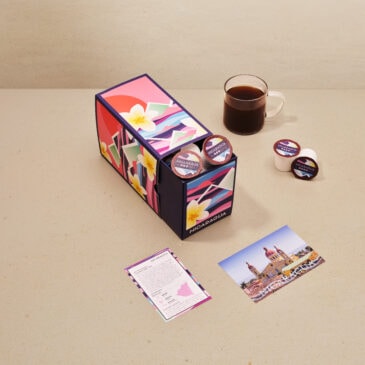Single-serve capsule brewers, like Keurig, are hugely popular among busy coffee lovers for their convenience and ease of use. Overall, these machines are equally easy to maintain.
When it comes to draining all of the water from your Keurig, however, things can get a little more complicated.

"The best coffee pod I've ever tasted"
Yes, we mean that. Finally, specialty coffee for your KCup machine, roasted fresh to your order by our friends at Atlas Coffee in Austin, TX! Get 50% OFF to try it with code ROASTYPODS

Internal and External Water Tanks
Many of these coffee machines make use of both an external water tank and an internal water reservoir, keeping water primed within the machine for the next cup of joe.
This is no problem if your Keurig is being used regularly because new water cycles through with each cup of coffee brewed.
However, it’s not a good idea to leave any water in the internal tanks if you plan to store your Keurig – it’s a breeding ground for mold and bacteria – and, if you store the Keurig in a cold environment like a garage, the water can freeze and damage the machine.
It’s also wise to drain your Keurig completely if you plan to transport the machine, in order to reduce the risk of spillage.
The Internal Reservoir: Not Simple To Drain
While it’s simple enough to empty the external reservoir, there is no straightforward way to drain all of the water from the internal tank.
Keurig’s official stance is that there is no way to drain the water from the internal reservoir once the machine has been primed.
All of the DIY methods below aren’t sanctioned by Keurig, so please do so only if you are comfortable using tools and taking apart and reassembling your Keurig.
You should also be aware that these DIY methods may void your warranty. If your Keurig is still covered by its warranty, you may want to avoid these methods.
How To Drain A Keurig Mini, Keurig Mini Plus, or K15
The Keurig Mini, Mini Plus, and K15 are the only Keurig coffee makers that can be completely drained, according to Keurig support.
These instructions won’t void your warranty and don’t require any disassembly.
If you store or transport your Keurig often, or it frequently goes unused for long periods of time, consider investing in one of these models for easy draining.
What You’ll Need
- Your Keurig Mini, Mini Plus, or K15
- A mug or other container
Step One: Turn Off The Machine
Turn off your brewer, leaving it plugged in.
Step Two: Place a Mug
Place your mug or another container under the spout of your Keurig. You won’t be drinking this, so any cup will do!
Step Three: Lift The Handle
Lift the brewer handle as if you were going to load a K-Cup, and then put it down again.
Step Four: Hold The Button
Press and hold the brew button until water flows into the coffee mug.
It should take about 5 seconds for the water to start to drain. Once all of the water has drained, you can discard it.
How To Drain a Keurig Classic (The Simple Way!)
Try this simple method first!
What You’ll Need:
- Your Keurig Classic
- A mug or cup
Step One: Empty the Water Reservoir
Remove the reservoir from your Keurig and pour out the water. Put it back onto the machine, empty.
Step Two: Trick The Keurig
Your Keurig won’t brew if there isn’t any water in the reservoir, but you can try to “trick” it into thinking that the reservoir isn’t empty.
Inside the water tank is a small plastic disk that floats up when the tank is filled. Reach inside and slide the disk up with your fingers.
The light should stop flashing and the screen of your Keurig should no longer display “Add Water.”
Step Three: Brew a Serving
Open and shut the lid on your Keurig as if you were loading a K-Cup and select a size to brew.
Your coffee maker should now brew a cup using the water that is left in the internal water tank.
Step Four: Discard The Water
Pour out the water that was dispensed from your Keurig. The screen should display “Prime.”
If this method works for you, it will leave only a small amount of water in your Keurig. Didn’t work? Don’t worry! Read on for another way to drain water from your Keurig Classic.
How To Drain Water From a Keurig Classic
If the “trick the water tank” method doesn’t work for you, you’ll need to try a method that requires some tools and disassembly.
Be sure to pay close attention to each step as you take apart your Keurig so that you can put it back together correctly.
Remember, this is not recommended by Keurig and will void any warranties you might have.
If you still need to drain your Keurig’s water tank for storage or transport and want to give this method a try, read on.
What You’ll Need:
- Flat-head screwdriver
- Needle-nose pliers
- Small zip ties (optional)
- Scissors
- Small plastic straw (optional but helpful)
Step One: Remove Screws From the Pod Compartment
Lift the lid of the pod compartment as if you were going to put in a K-Cup.
You’ll see two screws on the underside of the pod compartment lid. Use the flat-head screwdriver to remove these.
Step Two: Remove the Top of the Machine
With the screws removed, you should be able to lift the top of the pod compartment where it says “Keurig.”
Lift this and slide it off, exposing the inner tubing of the machine.
Step Three: Detach Tubes From the Internal Water Tank
You’ll see two silicone tubes attached to the top of the internal water reservoir. One will be at the top, and one will be toward the back-right.
The tubes will be affixed to metal pieces within the machine by small zip ties.
You have two choices here – wiggle the zip ties up and off of the metal attachments using needle-nose pliers, or snip them (with the intention of replacing them with new zip ties later).
Once the zip ties are out of the way, detach the tubes.
Step Four: Pour Out The Water
Flip the Keurig upside down and pour out the water.
You can speed up the process by inserting your small plastic straw into the opening at the top of the tank where one of the tubes was previously attached.
Step Five: Put It Back Together
Flip your Keurig right side up and replace the silicone tubes.
Use your needle-nose pliers to slide your zip ties back into place, or use new zip ties to affix the tubes the way they were before.
Put the top back on and reattach it with screws.
That’s it! You’ve drained your Keurig Classic.
How To Drain A Keurig 2.0
Draining water from the internal tank of your Keurig 2.0 is somewhat involved – you’re going to be taking apart the shell of the machine.
Pay attention as you go so that you can reassemble it properly!
Again, don’t do this if you have a warranty on your machine and don’t want to void it!
What You’ll Need:
- Phillips-head screwdriver
- Needle-nose pliers
Step One: Detach Chrome Ring
Push in and up on the chrome ring behind the pod assembly to remove it.
Step Two: Remove The Screws From The Bottom Of The Machine
Flip your Keurig over and use a Philips-head screwdriver to remove the screws from the bottom plate.
Step Three: Remove The Front Of The Brewer
Remove the front panel by sliding it out to unhook and then pulling it outward. You may need to use some force to do this.
Step Four: Remove The Top Of The Machine
Turn your Keurig to the water reservoir side and use your Philips-head screwdriver to remove the two screws near the top.
After removing the screws, use a flat object to pry around the top of the brewer to separate it from the rest of the coffee machine.
Step Five: Remove The Exterior Covering
Remove the exterior covering from around the sides of the machine. You’ll have to use some force to pry it away from the base of the Keurig.
Step Six: Drain The Water Intake
There are two tubes attached to the water intake assembly. Remove them and press down on the center of the intake piece to drain the intake.
Step Seven: Remove The Screws From The Internal Components
There are two more screws you need to remove – one is at the base of the motherboard. The other is on the other side, holding together the filter assembly, pump, and internal water tank.
Gently free the entire assembly from the base.
Step Eight: Detach and Drain The Filter
Firmly pull the silicone tube that attaches the internal filter to the pump assembly to detach it.
Step Nine: Detach The Top Tube
There is a tube attached to the top of the water tank – pull this out. This will help the water to drain better because air will be able to come in and displace it.
Step Ten: Drain The Brewer
Remove the tube that connects the water tank to the pump. Water should immediately begin to drain out of the tank.
Step Eleven: Reassemble The Machine
Work backward through these steps to carefully put your Keurig back together. The Keurig 2.0 is now drained and can be stored or transported.
Frequently Asked Questions
Do I Need To Drain My Keurig?
Keurig’s official stance is that most of their coffee makers cannot be fully drained once they have been primed.
However, if you plan to store your Keurig for a long period of time, especially in a cold environment, it’s best to drain the water from both tanks to avoid mold, bacteria, or freezing.
If your Keurig sees long periods of disuse, consider a Keurig Mini, Mini Plus, or K15. These models are easy to fully drain without disassembly.
How Do I Drain My Keurig 2.0 Fully Without Disassembly?
Unfortunately, the Keurig 2.0 must be disassembled in order to drain it fully, and the Keurig company doesn’t recommend or support this. We think it’s doable with a little patience, but be aware it can void your warranty if you have one.
How Long Can You Leave Water In A Keurig?
In general, aim to leave water in your Keurig for no longer than around 3-4 days. You can read more on this topic here.
Can You Use Tap Water In A Keurig?
It’s fine to use tap water in your Keurig. However, you may find that filtered water gives your coffee a better taste.
The minerals that are present in tap water may lead to the buildup of limescale, but you can easily combat this by descaling your Keurig from time to time.
Can You Use Distilled Water In A Keurig?
We have more information about this here, but the short answer is that distilled water isn’t the best choice for use in a Keurig.
It can cause the machine to break down faster, and the Keurig 2.0 won’t operate properly when filled with distilled water.
Do Keurigs Get Moldy Inside?
It’s definitely possible for your Keurig (and all coffee makers) to grow mold or mildew inside. You can help prevent this by regularly cleaning your Keurig.
Can You Leave Vinegar In Your Keurig Overnight?
First of all, don’t use straight vinegar to descale your Keurig. We recommend a mix of equal parts white vinegar and water.
It’s not necessary to leave the vinegar solution in your Keurig overnight; you should aim for around 30 minutes up to a few hours.
Happy Caffeinating!







